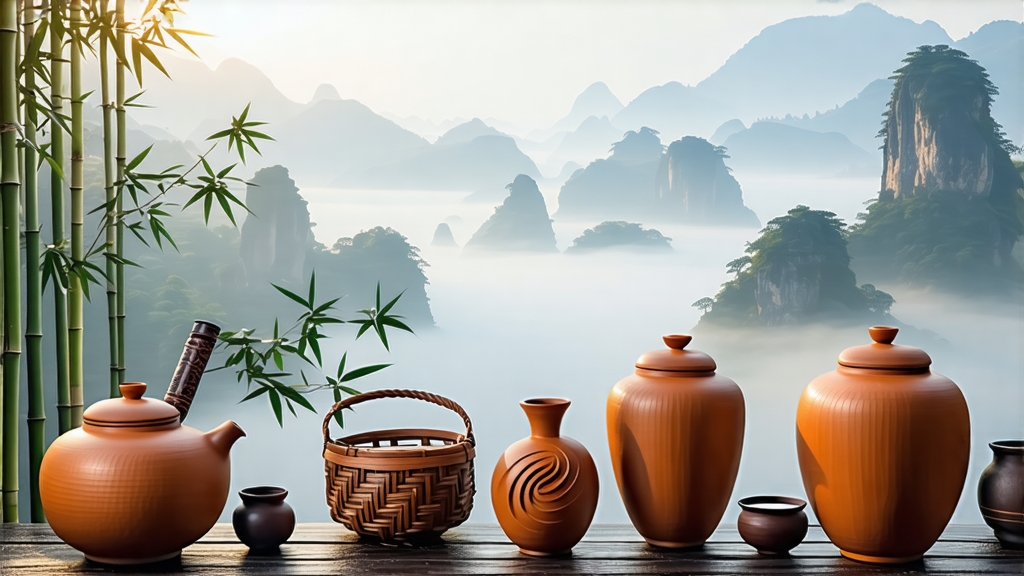
Tucked away in the southern folds of China’s Guangxi Zhuang Autonomous Region, where limestone pinnacles poke through perpetual mist, Liu Bao tea has been quietly fermenting its way into the cups of emperors, merchants, and modern connoisseurs for more than 1,500 years. To the uninitiated, Liu Bao is simply another dark brick in the wall of Chinese “black” teas (what the West calls “dark” or post-fermented teas). To those who listen, it is a liquid archive of caravan bells, riverboats, and the humid breath of sub-tropical cellars. This article invites you to travel with that archive—from Tang dynasty frontier posts to 21st-century specialty cafés—learning how a single leaf can embody both geology and genealogy.
-
A Leaf Forged by Geography
The Liu Bao valley lies at the confluence of the Wu and He rivers, where acidic red soils, diurnal mountain mists, and the mineral-rich runoff from karst peaks create a terroir uniquely suited to large-leaf Assamica tea trees. Locals insist that the same water that dissolves limestone into subterranean caves later irrigates the tea gardens, imparting a subtle stone-sweetness that no other dark tea can replicate. The name “Liu Bao” literally means “six fortresses,” a reference to Ming-era garrisons that protected the tea roads leading to Guangdong’s Pearl River Delta and, ultimately, to the tea-hungry markets of Hong Kong and Southeast Asia. -
From Tribute to Cargo: A Brief History
During the Qing Qianlong period (1736–1795), Liu Bao was listed among the “xiāng chá” (tribute teas) shipped to the imperial court in Beijing. Yet its greater fame came through the so-called “Tea Road to the Sea.” Compressed into 40-kilogram bamboo baskets, the tea traveled on mule back to Wuzhou, then by junk to Hong Kong, where dock workers noticed that the hotter and more humid the hold, the faster the tea mellowed. By the early 20th century, Liu Bao had become the signature drink of Guangdong’s dockside teahouses, prized for its ability to cut through grease and aid digestion after a heavy dim-sum breakfast. Overseas Chinese communities in Kuala Lumpur and Singapore adopted it as the “coolie’s coffee,” a cheap, sustaining brew that could be re-boiled all day without turning bitter. -
Varieties: The Basket, the Brick, and the Loose
Although all authentic Liu Bao originates from the eight surrounding villages, three traditional forms dominate the market:- Basket Tea (sǎn zhuāng): leaf packed into double-layered bamboo husks, allowing micro-oxygenation; the classic 40 kg “big basket” is still used for long-term aging.
- Brick Tea (zhuān chá): steamed leaf compressed under stone weights into 2–5 kg rectangular blocks, favored by collectors for their tidy stacking and slower aging curve.
- Loose Tea (sǎn chá): simply dried and boxed, preferred by restaurants that need quick infusion and by home drinkers who want to watch the leaf unfurl.
Modern producers also press mini-cakes (100 g) and tiny “tuo” nests (5 g) for the gift market, but purists argue that the bamboo basket remains the only vessel that breathes in sync with Liu Bao’s microbial soul.
-
Crafting the Darkness: A Six-Act Play
Step 1: Plucking—only the standard “one bud with three to four leaves” is taken after the early-spring rains, when the Assamica leaves have grown broad and thick enough to withstand the rigors of post-fermentation.
Step 2: Wilting—leaves are spread on bamboo trays under shade for 4–6 hours, driving off grassy volatiles while retaining the mountain coolness.
Step 3: Kill-Green (shā qīng)—a brief 3–4 minute roast at 160 °C deactivates oxidative enzymes, but unlike green tea, the goal is only partial denaturation, leaving enough microbial substrate for later fermentation.
Step 4: Rolling—traditional foot-rolling on rattan mats bruises the leaf margins, encouraging the release of polyphenols while keeping the veins intact.
Step 5: Sun-Drying—leaf is scattered on raised bamboo racks for two full days, locking in